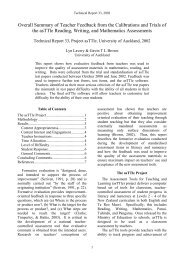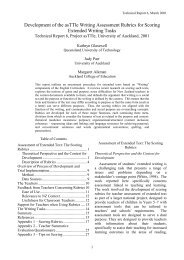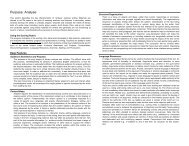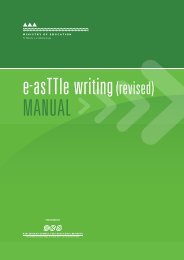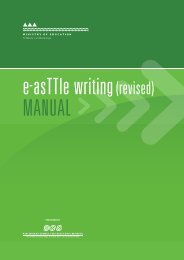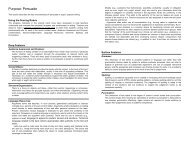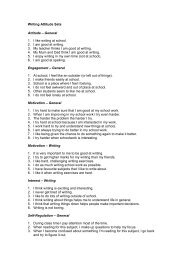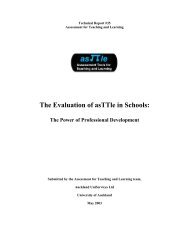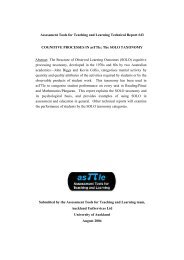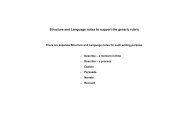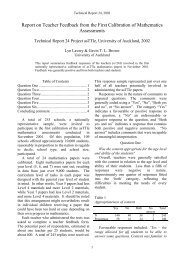11. Maths in the NZ curriculum 2001.pdf - e-asTTle - Te Kete Ipurangi
11. Maths in the NZ curriculum 2001.pdf - e-asTTle - Te Kete Ipurangi
11. Maths in the NZ curriculum 2001.pdf - e-asTTle - Te Kete Ipurangi
Create successful ePaper yourself
Turn your PDF publications into a flip-book with our unique Google optimized e-Paper software.
<strong>Te</strong>chnical Report 11: Mapp<strong>in</strong>g <strong>the</strong> Ma<strong>the</strong>matics Curriculum 11<br />
understand<strong>in</strong>g fractions and decimals and some<br />
strategies could be seen as prerequisite to<br />
operat<strong>in</strong>g effectively at Level 4 of Mi<strong>NZ</strong>C.<br />
This approach would need considerable<br />
research and discussion, as <strong>the</strong> notion of a range<br />
of strategies at each stage is pivotal to <strong>the</strong><br />
Learn<strong>in</strong>g Framework for Number. In terms of<br />
higher ma<strong>the</strong>matics, however, <strong>the</strong>re may be<br />
some ways of th<strong>in</strong>k<strong>in</strong>g that are more powerful<br />
than o<strong>the</strong>rs, and some of <strong>the</strong>se may be<br />
necessary <strong>in</strong> order to grasp later concepts.<br />
L<strong>in</strong>k<strong>in</strong>g certa<strong>in</strong> strategies with specific<br />
achievement objectives at each level may br<strong>in</strong>g<br />
<strong>the</strong>se two analyses toge<strong>the</strong>r.<br />
Strategies, knowledge, skills, and<br />
understand<strong>in</strong>gs. Objectives with<strong>in</strong> Levels 2 to<br />
4 of <strong>the</strong> ma<strong>the</strong>matics <strong>curriculum</strong> specify both<br />
th<strong>in</strong>gs that students should know and th<strong>in</strong>gs that<br />
students should do. The terms knowledge and<br />
skills are often used respectively to describe<br />
<strong>the</strong>se, but this term<strong>in</strong>ology is problematic. The<br />
<strong>curriculum</strong> l<strong>in</strong>ks <strong>the</strong> two terms: “...while such<br />
skills [algorithms] are important, a consequence<br />
of a narrow assessment regime which isolates<br />
discrete skills or knowledge is that students tend<br />
to learn <strong>in</strong> that way” (M<strong>in</strong>istry of Education,<br />
1993a, p. 15).<br />
This leads to difficulties. If a child knows<br />
<strong>the</strong> algorithm for two-digit addition, is this a<br />
skill <strong>the</strong>y have, knowledge <strong>the</strong>y possess, or a<br />
strategy for solv<strong>in</strong>g appropriate problems? Do<br />
skills become knowledge when <strong>the</strong>y are<br />
automatic? Is a strategy a skill, or is it<br />
knowledge? The Advanced Number Project<br />
identifies strategies and knowledge as two<br />
components of numeracy, and promotes <strong>the</strong>m<br />
alongside each o<strong>the</strong>r, not<strong>in</strong>g that certa<strong>in</strong><br />
knowledge is necessary <strong>in</strong> order to develop<br />
strategies, and vice versa (M<strong>in</strong>istry of<br />
Education, 2001a).<br />
This debate becomes important when we<br />
consider <strong>the</strong> <strong>curriculum</strong> <strong>in</strong> terms of a concept<br />
map. Are we mapp<strong>in</strong>g <strong>the</strong> acquisition of<br />
knowledge or <strong>the</strong> emergence of skills? We<br />
might consider <strong>the</strong> ma<strong>the</strong>matical processes<br />
strand to cover <strong>the</strong> skills necessary for<br />
ma<strong>the</strong>matics, and <strong>the</strong> content strands to cover<br />
<strong>the</strong> knowledge, but this is an oversimplification.<br />
Holton (1999) recommends <strong>the</strong><br />
explicit teach<strong>in</strong>g of problem-solv<strong>in</strong>g strategies:<br />
this leads to <strong>the</strong> question of whe<strong>the</strong>r problemsolv<strong>in</strong>g<br />
strategies when mastered become skills<br />
or knowledge.<br />
“Know<strong>in</strong>g about” and “do<strong>in</strong>g” ma<strong>the</strong>matics<br />
are bound toge<strong>the</strong>r <strong>in</strong> a reciprocal relationship.<br />
Recognis<strong>in</strong>g this reciprocity <strong>in</strong> plann<strong>in</strong>g,<br />
teach<strong>in</strong>g, and assessment is important to ensure<br />
balanced development of concepts.<br />
Summary<br />
This report presents two maps of <strong>the</strong><br />
Ma<strong>the</strong>matics <strong>in</strong> <strong>the</strong> New Zealand Curriculum<br />
(Mi<strong>NZ</strong>C) document (M<strong>in</strong>istry of Education,<br />
1993a). The first map traces <strong>the</strong> development<br />
of achievement objectives from Level 2 to<br />
Level 4, <strong>in</strong>dicat<strong>in</strong>g with<strong>in</strong> eight broad <strong>the</strong>matic<br />
areas how <strong>the</strong> objectives are l<strong>in</strong>ked. The second<br />
map serves as an adjunct to <strong>the</strong> first, giv<strong>in</strong>g an<br />
overview of each level. Objectives are<br />
organised <strong>in</strong> terms of process skills and activity<br />
types, while <strong>the</strong> content strands are not<br />
separated out. This map shows how <strong>the</strong> process<br />
objectives can be viewed across <strong>the</strong> five content<br />
strands, and how <strong>the</strong> prescription at each level<br />
is balanced <strong>in</strong> terms of <strong>the</strong>se processes.<br />
The objectives drawn from <strong>the</strong> <strong>curriculum</strong><br />
correspond to a period of rapid cognitive<br />
growth and change <strong>in</strong> understand<strong>in</strong>gs about<br />
ma<strong>the</strong>matics. This has been explored by <strong>the</strong><br />
new numeracy <strong>in</strong>itiatives, which have<br />
developed a strategy and knowledge framework<br />
for <strong>the</strong> primary school years. Objectives,<br />
particularly <strong>in</strong> <strong>the</strong> number strand, <strong>in</strong>clude many<br />
concepts and skills that are not itemised. This<br />
has many implications for assessment.<br />
The Ma<strong>the</strong>matics <strong>in</strong> <strong>the</strong> New Zealand<br />
Curriculum document has been used as a basis<br />
for plann<strong>in</strong>g and assessment by teachers, who<br />
often use <strong>the</strong> broad objectives set out with<strong>in</strong> <strong>the</strong><br />
document as checklist items. Schools have<br />
worked <strong>in</strong>dependently on develop<strong>in</strong>g criteria for<br />
assess<strong>in</strong>g performance at <strong>the</strong> various levels, and<br />
various publications have also sought to help<br />
with this. The apparent clarity of <strong>the</strong> document<br />
belies <strong>the</strong> complex understand<strong>in</strong>gs implied by<br />
<strong>the</strong> achievement objectives.





